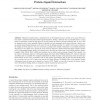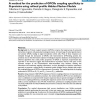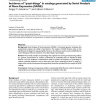431 search results - page 48 / 87 » The predictability of branches in libraries |
JCC
2011
12 years 10 months ago
2011
: Molecular recognition plays a fundamental role in all biological processes, and that is why great efforts have been made to understand and predict protein–ligand interactions. ...
GECCO
2007
Springer
14 years 1 months ago
2007
Springer
This research uses a Design of Experiments (DOE) approach to build a predictive model of the performance of a combinatorial optimization heuristic over a range of heuristic tuning...
BMCBI
2005
13 years 7 months ago
2005
Background: G- Protein coupled receptors (GPCRs) comprise the largest group of eukaryotic cell surface receptors with great pharmacological interest. A broad range of native ligan...
BMCBI
2006
13 years 7 months ago
2006
Background: Designing novel proteins with site-directed recombination has enormous prospects. By locating effective recombination sites for swapping sequence parts, the probabilit...
BMCBI
2004
13 years 7 months ago
2004
Background: Serial Analysis of Gene Expression (SAGE) is a functional genomic technique that quantitatively analyzes the cellular transcriptome. The analysis of SAGE libraries rel...




